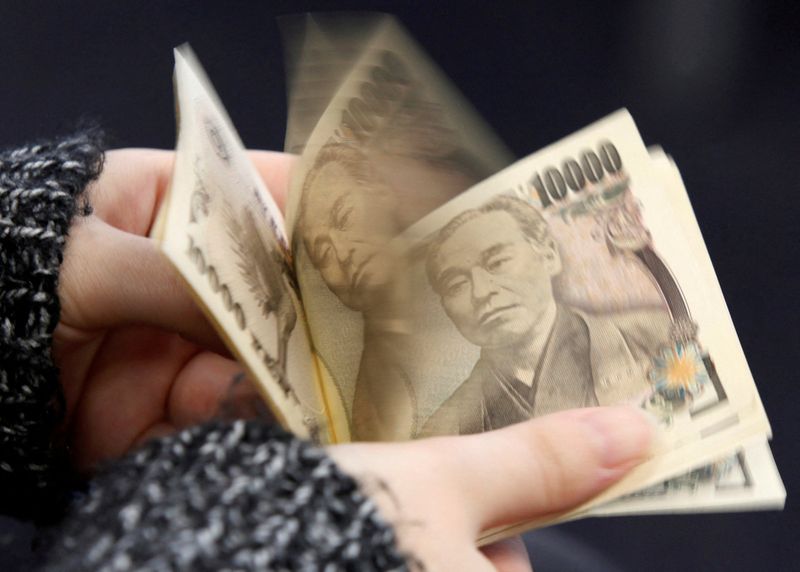Forex
Yen weak, dollar drifts as traders weigh Fed rate hike path


© Reuters. FILE PHOTO: A woman counts Japanese 10,000 yen notes in Tokyo, in this February 28, 2013 picture illustration. REUTERS/Shohei Miyano/Illustration/File Photo
By Ankur Banerjee
SINGAPORE (Reuters) – The yen remained hunkered just below the psychologically important barrier of 145 per U.S. dollar on Monday, while the dollar was on the back foot after U.S. economic data last week showed slightly easing inflation and consumer spending.
The yen weakened 0.09% to 144.45 to start the second half of the year, having lost 9% against the dollar in the first six months of the year.
Against the euro, the yen was hovering at 157.66, just under the 15-year low of 158 it touched last week. It rose to 183.58 per sterling, its highest since December 2015.
The Asian currency briefly passed 145 per dollar on Friday, hitting a near eight-month low of 145.07 as investors keep an eye on whether Japanese authorities will intervene in the currency market.
Finance Minister Shunichi Suzuki said on Friday Japan would take appropriate steps in response to excessive yen weakening, in the latest comment from government ministers and officials.
The comments from Suzuki helped curb the yen’s losses on Friday.
“Intervention is best conceived of as an escalation ladder,” said Marc Chandler, chief market strategist at Bannockburn Forex.
“Among the highest rungs is the coordinated intervention… The low rungs on the escalation ladder are different types of verbal intervention.”
Japan bought yen in September, its first foray in the market to boost its currency since 1998, after a Bank of Japan (BOJ) decision to maintain ultra-loose policy drove the yen as low as 145 per dollar.
It intervened again in October after the yen plunged to a 32-year low of 151.94.
Still, Japanese business sentiment improved in the second quarter as easing supply constraints and the removal of pandemic curbs lifted factory output and consumption, a central bank survey showed, a sign the economy was on course for a steady recovery.
Investor focus this week will be on the minutes of the U.S. Federal Reserve’s June meeting due on Wednesday.
The central bank decided to leave interest rates unchanged in its June meeting but hinted that borrowing costs may still need to rise by as much as half of a percentage point by the end of the year.
Economic data through last week painted a picture of resilient U.S. economy that eased recession worries but stoked expectations that the Fed will stick to its hawkish path.
But data on Friday showed cooler-than-expected inflation in May, while consumer spending abruptly decelerated, providing further evidence that the Fed’s hikes are having their desired effect.
“The U.S. economy is not slowing as forecast,” Citi strategists said in a client note. “Surprisingly strong job growth is keeping labour markets tight while providing the nominal spending power to drive services consumption.”
Markets are pricing in a 84% chance of the Fed hiking rates by 25 basis points in its July meeting, CME FedWatch tool showed.
Investor attention will also be on the Labor Department’s Job Openings and Labor Turnover Survey, or JOLTS, and monthly payrolls report due later this week that will help gauge the labour market in the United States.
NatWest Markets strategists expect the hiking cycle to be over, but noted that the lack of sufficient-enough progress in the inflation data could lead officials to hike by 25 bps again in July.
“The decision to act or not will be more data dependent than ever,” they said.
Against a basket of currencies, the dollar was at 102.86, having dropped 0.4% on Friday. After eking out a near 2% gain in the first half of the year, the euro made subdued start to the third quarter and was at $1.0916, up 0.05%.
Sterling last fetched $1.2704, flat on the day, after rising 5% in the first six months of the year.
steadied after slipping to near eight-month lows against the dollar at the end of last week, supported by the central bank’s intensified efforts to stabilise the much weakened local currency.[CNY/]
The Australian dollar rose 0.02% to $0.667, while the New Zealand dollar rose 0.42% at $0.615.

 Forex3 years ago
Forex3 years agoForex Today: the dollar is gaining strength amid gloomy sentiment at the start of the Fed’s week

 Forex3 years ago
Forex3 years agoUnbiased review of Pocket Option broker

 Forex3 years ago
Forex3 years agoDollar to pound sterling exchange rate today: Pound plummeted to its lowest since 1985

 Forex3 years ago
Forex3 years agoHow is the Australian dollar doing today?

 Cryptocurrency3 years ago
Cryptocurrency3 years agoWhat happened in the crypto market – current events today

 World3 years ago
World3 years agoWhy are modern video games an art form?

 Commodities3 years ago
Commodities3 years agoCopper continues to fall in price on expectations of lower demand in China

 Economy3 years ago
Economy3 years agoCrude oil tankers double in price due to EU anti-Russian sanctions





















